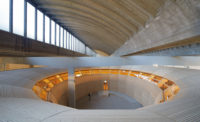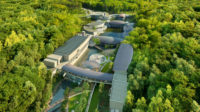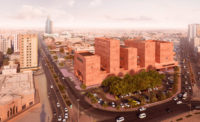Slanting white walls intersected by blue forms mark the exterior of a 2.5-story building designed by Studio Libeskind, led by Daniel Libeksind, for Lisbon’s upcoming Jewish Museum. The project, called Tikvah (Hebrew for “hope”),consists of a 41,645-square-foot structure created in collaboration with local architect Miguel Saraiva. It is to be built in Lisbon’s Belém area, southwest of the city center and marked by the 16th-century Tower of Belém along the Tagus River.
Renderings reveal a white, geometric structure broken up by glass portions that scale the height of the building, which is to be topped with a grassy roof and a walkway, framing the four-story tower in the distance with its wall-mounted turrets. Inside, the strong lines of the exteriors are further revealed, with white walls interspersed with blue portions.
The museum is to be built on a plot across the street from the riverfront, with a series of outdoor steps leading up to a generous patio and entrance. Renderings show white lines that are to extend out from the base of the structure, across the grounds, to highlight the building’s geometric construction.
It was first announced that Libeskind would design the Jewish Museum—a collaboration between Lisbon City Hall (CML) and non-profit organization Association Hagadá—in December 2020. Originally meant to be built in Lisbon’s oldest neighborhood, Alfama, the museum is a 20-year effort, after a failed attempt in 2016. But in 2019 the municipality granted Association Hagadá a 50-year renewable lease on a plot in Belém with a license to build a museum, for which it selected New York-based Jewish architect Daniel Libeskind for the project. He has designed a number of similar museums, including the Jewish Museum Berlin, San Francisco’s Contemporary Jewish Museum and Copenhagen’s Danish Jewish Museum, as well as Holocaust memorials in the Netherlands and Canada, which completed in 2018 in Ottawa. Many, like the Lisbon design, also feature angled walls.
The establishment of a Jewish Museum in Lisbon is aimed to promote Portuguese Jewish life and its contribution to the history of Lisbon and beyond. Lisbon’s Jewish community in particular originated in the early 1800s, 300 years after the Edict of Expulsion and almost a century after the Inquisition, with Sephardic Jews mainly from Gibraltar and Morocco settling there as a colony and many finding work as tradesmen. “The museum will tell a unique story of almost two thousand years of longevity and plurality of cultures that give Portuguese Judaism a peculiar and very rich character,” said President of the Haggadah Association Esther Mucznik in a press release. “It is this history and this memory that the museum, with its bold and innovative project, will make known to the national and foreign public.”
In addition to the project in Lisbon, Studio Libeskind was also recently commissioned to create an architecture center in Łódź, Poland, where the architect grew up before moving to Israel and then New York.. The building, along with several other commissions by the architect, is part of a city-wide initiative called Nexus21 which is meant to reinvigorate areas of the city. Libeskind established his studio in Berlin with wife and business partner Nina in 1989, following the city’s Jewish Museum commission, and later relocated to New York City in 2003 after being selected as the master planner for the redevelopment of World Trade Center.












Post a comment to this article
Report Abusive Comment